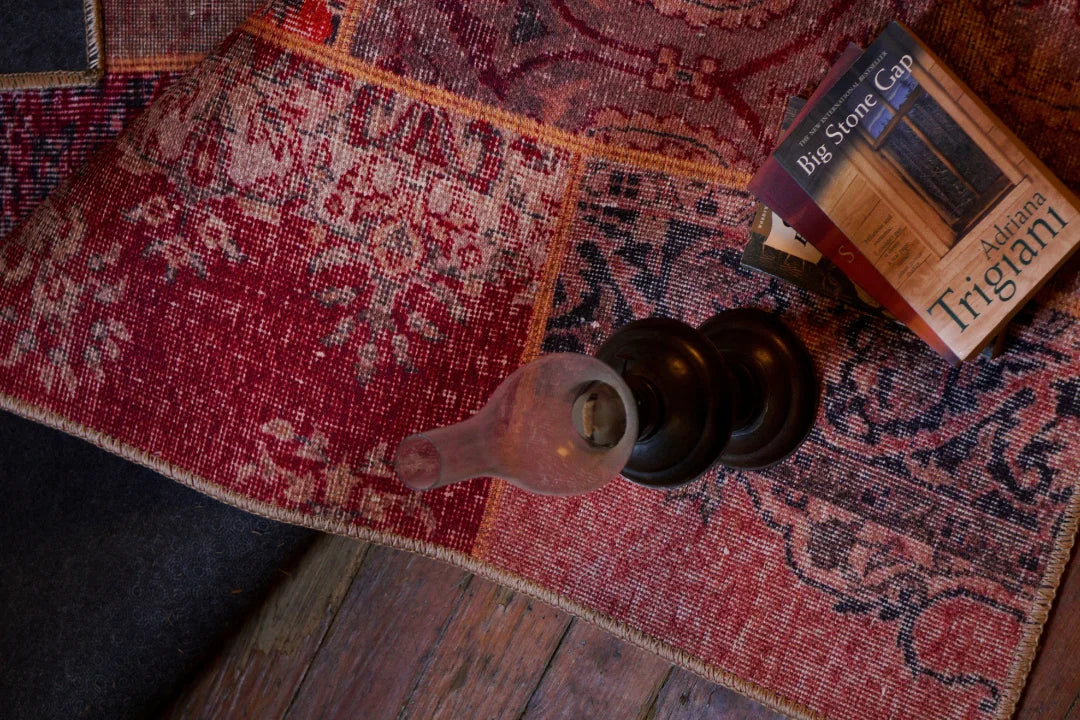
How to Style Vintage Rugs in Modern Egyptian Homes

There’s something quiet and human about a rug that carries a past. In Egypt, where the Nile and streets of Cairo have seen centuries of hands weaving color and story, a vintage rug is more than a floor covering. It is memory laid out, a patch of history that anchors the present. Using vintage rugs in modern Egyptian homes is not only an aesthetic choice, it’s an act of linking generations.
This guide is for the homeowner who wants their living room to say more than “ stylish.” It is for the person who wants texture and lineage, who wants a rug that looks as though it’s already part of a family story the moment it arrives. We’ll talk about what makes a rug vintage, how to place and pair one in each room, color and pattern rules that actually work, real-life styling tips from Egyptian interiors, and how to care for these pieces so they live long enough to become heirlooms.
What “Vintage” Means (and Why It Matters)
People sometimes use “vintage” and “antique” as if they were the same. In the world of rugs, there are different notes on the same scale. An antique rug is typically over 100 years old and often rare; a vintage rug is older than a modern reproduction but not necessarily an antique; it might be 50 to 100 years old, or even a well-aged mid-century piece. Both vintage and antique rugs have a life lived into their threads: repairs, softened fringes, slight fading; these are not flaws, they are the proof of life. For more about what defines a vintage rug, many global rug experts provide deeper insights.
Why Vintage Rugs Work in Modern Homes
There are practical reasons and emotional reasons. Practically, vintage rugs are often well-made; natural dyes, hand-knotted techniques, and sturdy foundations mean they can take years of wear. Emotionally, they provide texture and depth. A neutral sofa paired with a bold, time-softened rug suddenly becomes layered and personal.
In Egypt, many modern homes mix Mediterranean light, minimalist furniture, and open-plan living. A vintage rug acts like a cultural translator in those rooms, it says, “This place has history.” Even in contemporary apartments in New Cairo or Zamalek, a vintage rug can invite warmth, ground the furniture layout, and provide a tactile connection to the country’s broader textile story. See also how Architectural Digest explores styling vintage rugs worldwide.

Styling Rooms, Practical Recipes That Tell a Story
Living Room, Let the Rug Lead
Start with scale. A living room rug should anchor the main seating group. For modern Egyptian living rooms with low sofas and wooden accents, choose a vintage rug that’s large enough that at least the front legs of the sofas sit on it. If the rug has a strong central medallion, align it with the coffee table and sofa to form a deliberate focal point.
Balance patterns. If you have patterned cushions or wallpaper, use the rug as the “calmer” pattern or vice versa. A common approach that works in Cairo apartments is a muted vintage rug with a single bold contemporary cushion pattern; the eye moves; the room breathes.
Bedroom, Make It Intimate
Bedrooms are forgiving: a vintage rug placed under the bed and stretching out on both sides reads intimate and grounded. For smaller rooms, consider a runner at the foot of the bed. In master suites with hardwood or stone floors, a rug immediately adds softness underfoot in the mornings.
Dining Room, Be Practical
Use a classic rug large enough so chairs remain on the rug when pulled out. Choose vintage rugs with tighter weaves for dining areas; they handle the occasional spill better and are easier to clean professionally. Neutral palettes with subtle motifs work well to keep the food on the table and the visuals uncluttered.
Entryway and Hall, Make a Promise
Entrances set expectations. A long, narrow runner with a worn-in center tells visitors that this home is lived in and loved. Choose durable flatweave vintage pieces here; they can survive high traffic and still age beautifully.
Mixing Old and New, The Key Moves
There are three simple mixing rules I use when styling vintage rugs with modern furniture:
- Echo colors: Pull one or two subtle colors from the rug into cushions, throws, or an artwork. This creates visual harmony without forcing everything to match.
- Play contrast: Pair ornate rug patterns with clean-lined furniture. The contrast makes both elements stronger.
- Layer carefully: If you layer rugs, keep the vintage piece on the bottom and add a smaller, modern accent rug on top for texture and protection. See some creative approaches in House Beautiful.

Color and Pattern Pairing That Works in Egyptian Light
Egyptian light is generous, with long, warm afternoons and clear contrasts. That means color reads differently here than in northern European spaces. Jewel tones in vintage rugs (deep indigo, pomegranate red, saffron accents) will glow in sunlight. Earth tones (burnt umber, sand, olive) harmonize with limestone and wood floors common in Egyptian homes.
Patterns: Oriental motifs, medallions, boteh (paisley), repeating geometric borders, pair beautifully with modern minimalism when balanced by solid blocks of color in upholstery. If your rug pattern feels busy, simplify surrounding textiles to solids and soft textures. If your rug is simple, you can use more adventurous contemporary patterns nearby. Learn more about color and pattern balance in rugs.
Choosing Vintage Rugs, Authenticity and Budget
Not every vintage rug needs to be extremely rare. A genuine mid-century freestanding factory-made carpet with an authentic patina can be just as soulful as an antique Persian. When shopping in Egypt, you’ll find a range from restored workshop pieces to imported Oriental antiques. Ask sellers about provenance and condition. Also, check the rug’s foundation: a tight knot density and natural fibers (wool, cotton foundation) usually mean a longer life.
Budget tip: Sometimes small repairs and professional cleaning can transform an overlooked piece into a living focal point at a fraction of the price of a pristine antique. For eco-conscious buyers, check our guide on sustainable and eco-friendly rugs in Egypt.
Practical Care, Keep the Story Intact
Preserving vintage rugs is simpler than many expect if you follow a few habits:
- Rotate regularly: Turn your rug every few months to equalize wear in sunlit rooms and avoid one-sided fading.
- Use padding: A proper rug pad protects the rug and prevents slipping. It also reduces friction and extends life.
- Deal with spills quickly: Blot, don’t rub. For stains, consult a professional specializing in vintage rug restoration rather than using household chemicals.
- Professional cleaning: Once every 2–4 years, depending on traffic. Cleaners experienced with hand-knotted and vegetable-dyed rugs will know how to respect colors and structure. The NYC Carpet Cleaning guide has useful expert advice.
Where to Source Vintage and Classic Rugs in Egypt
You can find pieces in several places: local souks and bazaars for raw finds, restorers and dealers in Cairo for cleaned and repaired pieces, and online sellers who specialize in vintage rugs. Khyaal-store curates pieces that balance authenticity and usability, and companies like Oriental Weavers also offer classic-inspired collections if you want a classic look with modern performance. For alternatives, see our article on carpet alternatives for Egyptian homes.

Real-Life Styling Examples, Short Case Stories
Case 1, A flat in Zamalek: The owner kept a modern low-profile sofa and added a warm, faded Persian runner across the length of the room. She echoed the runner’s deep rust in a single cushion and a ceramic lamp. The result felt collected rather than styled.
Case 2, A contemporary villa in New Cairo: Architects used a large, neutral-toned vintage rug under a sculptural contemporary sofa. Because the rug’s pattern was soft, they added a single bold art piece above the sofa to anchor vertical space without competing with the floor.
Case 3, Small apartment hack: In a compact studio, a layered approach worked: a small vintage mat under a modern coffee table, topped with a textured neutral rug. It protected the vintage piece and gave an immediate lived-in warmth. For more design inspiration, Apartment Therapy shares real-life examples.

Buying Tips , Questions to Ask
When you see a rug you love, ask:
- What is the fiber (wool, silk, cotton)? Wool is the most forgiving for everyday use.
- Where does it come from? (Region often indicates style and technique.)
- Has it been professionally cleaned or restored? Ask for before-and-after photos.
- Are there any moth holes or structural damage? Small repairs are usually okay; ask for a repair estimate.
Frequently Asked Questions , Styling Vintage Rugs
- How do I know if a rug is truly vintage?
- Look for signs of age like softening of pile, minor repairs, natural dye fading, and a hand-knotted foundation. Ask the seller about provenance and any restoration history.
- Can vintage rugs handle pets and children?
- Yes, many vintage wool rugs are durable. Use a protective rug pad and be prompt with spill care. For high-traffic homes, choose a tighter woven piece or layer a modern rug on top.
- How often should I clean a vintage rug?
- Routine vacuuming (without beater-bar on delicate pieces) and professional cleaning every 2–4 years, depending on traffic, usually suffices. Always use cleaners experienced with vintage textiles.
- Can I use a vintage rug outdoors?
- Generally, no. Vintage rugs are best kept indoors to avoid sun damage, moisture, and accelerated wear. Outdoor-friendly modern rugs are a better choice for terraces.
Bringing Heritage Home, A Final Note
Vintage rugs do something modern furniture cannot: they carry a sense of continuity. In Egyptian homes, where family and memory are central, placing a rug isn’t only an interior decision, it’s cultural curation. The right vintage piece will age with you, collect footfalls and sunlight, and become part of your household’s visual language.
If you’re ready to explore or need help matching a vintage rug to your living space, start by measuring the room, choosing the main seating anchor, and thinking about the color story you want to live with. Invite texture and leave room for imperfections; they are evidence of life.
